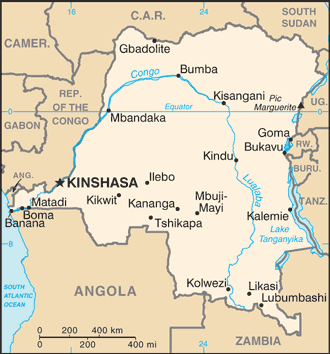Congo river steamers

The Congo River is divided into three navigable parts, by seagoing ship to Matadi, where there is a wharf and port, a rail bypassing the mighty falls for 200 miles; and then a middle section of over 1000 miles from Leopoldville (Kinshasa) to Stanleyville (Kisangani) where the Stanley Falls breaks the river. The upper section of the river is navigable to Lubumbashi, a measure of 400 miles . The large copper deposits of Katanga are conveyed from Elisabethville (Lumbumbashi). The Congo River was an open river in that it was free for all nations to use as per an 1885 international agreement, which was tested by a Brit in the International Court in 1931.

The first river steamers on the Congo were two built in sections and hauled overland to the middle river by Henry Morton Stanley the explorer in 1879. Stanley was instrumental in making the area the personal territory of Leopold II .
The Oxford Baptist Missionary Society and its chief agent George Grenfell built the steamer Peace for evangelical work in the area in the 1884 . Grenfell led both in contact with the natives and charting and exploring the river system. He would later built 2 larger steamers, one called Goodwill.
Author Joseph Conrad steamed on one trip up the Congo and used the trip as an inspiration for his famous novel Heart of Darkness.

Conrad was promised a job as a Congo River pilot through the influence of his distant cousin Marguerite Poradowska, who lived in Brussels and knew important officials of the Belgian company which exploited the Congo for its rubber . At this time the Congo, though nominally an independent state, the Congo Free State was virtually the personal property of Leopold II, King of the Belgians, who made a fortune out of it. Later, the appalling abuses involved in the naked colonial exploitation that went on in the Congo were exposed to public view, and international criticism compelled the setting up of a committee of inquiry in 1904 . What Conrad saw in 1890 shocked him profoundly and shook his view of the moral basis of all exploring and trading in newly discovered countries and indeed of civilization in general.
As a result of Belgian outrage at the violence brought to the Congo by Leopold, the government in Belgium came under control of the Congo in 1908 (conditions quickly improved under fair government control) . A portage railway, the Matadi–Kinshasa Railway was built from Matadi to Leopoldville. Other railways were built around Stanley Falls, and on the rocky sections of the upper Congo. A Congo to Nile Railway was planned to connect Stanleyville with the Nile at Uganda. Over 100 steamers on the river by 1900. British and American missionary societies were sent to spread the gospel and monitor governments . Mining companies were set up in the copper belt of Katanga Province, and the Societe Maritime de Haut Congo was established. Railways radiated in a star pattern from Katanga, with lines to Angola, Zambia, and halfway to Leopoldville at Ilebo on the Kasai River. Later, ocean maritime empires Compagnie Maritime Belge and airlines, SABENA were formed to serve the colony.
Names of the riverboats included: Brugesville, Flandres, Milz, Deliverance, Henry Reed, Kigomi, Tadora, General Olsen, Brabant, and Kitambo. The steamer Bernaert was captured in a civil war of 1892.
OTRACO was the office of transport or Belgian government shipping agency on the Congo River after 1936.
Gaston Eve commented on traveling by boat during his time in Brazzaville during WWII with the Free French Forces.
"The voyage on the Fondère was very pleasant. That paddle steamer was very well run, the food excellent served in a fine refectory. We had cabins but in general slept on the deck. The nights were very beautiful. On the journey we were able to admire the forest lining the river and saw many types of monkey in the trees alongside it. Some were enormous and all this was new."
D'Lynn Waldron, who traveled through the Congo at the start of the crises in 1962, explained that:
"Most of the river boats were tiny Victorian relics, half rusted away and painted the color of rust so it wouldn’t show. Many of the larger riverboats had been towed across the Atlantic after outliving their usefulness on the Mississippi [(Sic), One boat on the Congo was a copy of the Mississippi type; U.S. boats would not have made the sea voyage nor the impassable lower falls.] These were big, old-fashioned, flat-bottomed, stern wheelers that drew only a few feet of water."
Large paddle steamers were built by the OTRACO agency and worked the river until the Civil War when boats were machine gunned and charges dropped into their boilers .
Bretonnet, Vivi in French Congo and Ubangi River. The north bank of the river was an entirely separate French colony with their own boats .
River steamers ran until the 1980s, when the kleptocracy of Mobutu crippled the country. They were replaced by diesel pushers .
Up to 150 people drowned when ferries collided on the river in 2010 .
See also
- George Grenfell
- Transport in the Democratic Republic of the Congo
- Geoffrey Spicer-Simson
- The African Queen (disambiguation)
- East African Railways
- Fashoda Incident
References
- "Steam Across Africa" New York Times, 1902.
- Waldron, d'Lynn. “The Secret in the Heart of Darkness: the Sabotaged Independence of the Belgian Congo”
Further reading
- Conrad, Joseph. Heart of Darkness
- Kingsolver, Barbara. Poisonwood Bible
- Butcher, Tim. Blood River.
- Online Diary of Hershey Longebecker